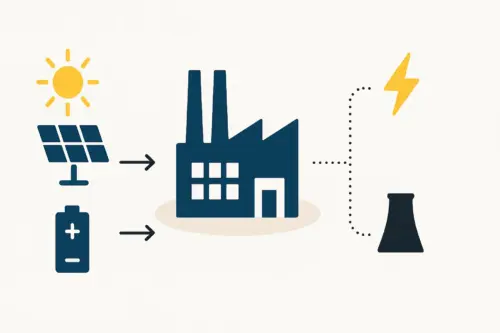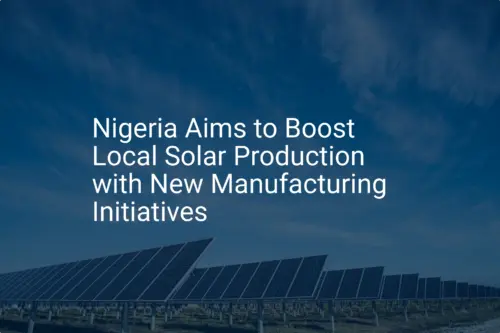An entrepreneur secures funding, commissions machinery, and finalizes the factory building. As the physical components for a new solar module manufacturing plant in Nigeria fall into place, a critical question is often underestimated until late in the process: who will operate the machinery?
Finding, training, and retaining a skilled technical workforce isn’t just an operational task; it’s the foundation for the success and profitability of the entire venture. This article outlines the essential labor considerations for establishing a solar panel assembly line in Nigeria. It covers talent acquisition strategies, the design of effective training programs, and a realistic analysis of labor costs to help business leaders navigate the human side of their investment.
Understanding the Labor Landscape in Nigeria for Manufacturing
For new industrial projects, Nigeria’s demographic profile presents both a key opportunity and a distinct challenge. With a large, youthful population and a national unemployment rate that has fluctuated around 33%, there is a substantial pool of available labor.
However, a gap often exists between the general availability of labor and the specific technical skills required for modern manufacturing. While many candidates possess a university education, the hands-on, vocational skills needed for precise assembly work—such as soldering, machine operation, and quality inspection—can be less common. A successful recruitment strategy, therefore, must focus less on pre-existing experience and more on identifying candidates with the right aptitude for structured training.
Defining the Essential Roles in a Solar Module Production Line
A semi-automated solar module assembly line depends on a team of operators and technicians, each with a clearly defined role. While a small-scale factory can begin with a lean team, clarity on these roles is crucial for effective recruitment and training.
A typical 50 MW line requires approximately 25 to 30 production personnel per shift, organized across several key functions:
Production Operators
The core of the assembly team, these individuals are responsible for specific stages of production, including solar cell stringing (connecting cells into rows), layup (arranging strings and materials), lamination (fusing the module components), and framing.
Quality Control (QC) Technicians
Tasked with ensuring every module meets international standards, these technicians perform critical checks. This includes visual inspection for defects, Electroluminescence (EL) testing to identify microcracks in cells, and IV testing (sun simulation) to verify power output.
Maintenance Technicians
These skilled technicians are responsible for the upkeep, calibration, and repair of the production machinery. Their proactive work is vital for minimizing downtime and maintaining production efficiency.
Line Supervisors
Experienced leaders who oversee the production flow, manage the team, troubleshoot minor issues, and ensure that safety and quality protocols are followed consistently.
Ready to make big Profits?
The solar Industry is Booming
WE HELP NEWCOMERS to the solar industry start their own solar module production line. Customers can make BIG PROFITS by selling modules and finding investors, without wasting money and time on things they don't need!
A Strategic Approach to Recruitment and Talent Acquisition
Given that direct experience in solar module manufacturing is rare in Nigeria, the recruitment process must be designed to identify potential and trainability.
Sourcing Candidates
A multi-channel approach often yields the best results:
- Technical and Vocational Institutions: Partnering with local Technical and Vocational Education and Training (TVET) centers can provide access to candidates with foundational skills in electronics, mechanics, or electrical work.
- Adjacent Industries: Recruiting individuals from industries like electronics assembly, telecommunications equipment repair, or automotive manufacturing can be highly effective. These candidates often possess transferable skills such as soldering, quality inspection, and adherence to process-driven work.
- University Graduates: For supervisory, engineering, and maintenance roles, graduates from university engineering programs are a strong talent pool.
The Vetting Process
The focus during interviews should be less on a candidate’s CV and more on their inherent capabilities.
- Aptitude and Attitude: Look for candidates who demonstrate strong attention to detail, manual dexterity, a willingness to learn, and the ability to work methodically.
- Practical Assessments: A simple, hands-on test can be remarkably insightful. A timed soldering task, a basic mechanical assembly challenge, or a visual defect identification test can reveal a candidate’s practical skills far more effectively than an interview alone. This practical approach is a core component of staffing a new turnkey solar module manufacturing line.
Designing an Effective Training Program from the Ground Up
For most new factories in emerging markets, building a workforce means creating a training program from scratch. This investment is non-negotiable and directly impacts production yield, product quality, and long-term operational costs. A comprehensive program is typically structured in phases and lasts four to six weeks.
Phase 1: Foundational Classroom Training
Before operators touch any machinery, they must understand the fundamentals. This initial phase covers:
- Basics of Photovoltaics: How a solar cell works and why each production step is important.
- Material Handling: Solar cells are extremely fragile and expensive; proper handling techniques are critical to prevent costly breakage.
- Workplace Safety: Protocols for working with industrial machinery and electrical equipment.
- Introduction to Quality Standards: Defining what makes a high-quality solar module.
Phase 2: Supervised, On-the-Job Machine Training
This is the most critical phase, where theory is put into practice. It must be led by an experienced expert—often an engineer provided by the equipment supplier as part of the commissioning process.
- Machine-Specific Operation: Trainees learn the step-by-step process for operating key machinery such as solar cell stringers and laminators.
- Process Discipline: The emphasis is on consistency and following the standard operating procedure (SOP) every time to ensure uniform quality.
- Basic Troubleshooting: Operators learn to identify common errors and understand when to alert a supervisor or maintenance technician.
Based on experience from J.v.G. turnkey projects, a well-executed training program is the single most important factor in minimizing initial material wastage, which can otherwise exceed 5% and severely impact profitability.
Phase 3: Continuous Improvement
Training doesn’t end after the first month.
- Cross-Training: Training operators on multiple machines creates a more flexible and resilient workforce, capable of adapting to production bottlenecks or staff absences.
- Advanced Training: Specialized training for QC personnel on new inspection techniques and for maintenance staff on preventative maintenance schedules.
Analyzing Labor Costs and Operational Efficiency
Budgeting for labor requires looking beyond basic wages to the total cost.
- Direct Costs: While wages vary by location and skill level, a semi-skilled production operator in a Nigerian industrial zone can command a monthly salary in the range of NGN 80,000 to NGN 150,000.
- Indirect Costs: These include expenses for recruitment, training materials, employee uniforms, and legally mandated contributions such as pension and health insurance.
- Productivity Metrics: The ultimate goal is to maximize output per employee without compromising quality. This efficiency directly influences the financial viability of the plant and is a key factor in calculating the overall investment requirements for a 20-50 MW setup. A well-trained and motivated team will achieve production targets faster and with less waste, leading to a faster return on investment.
Frequently Asked Questions (FAQ)
How many employees are needed for a small-scale solar factory?
A 50 MW per year factory operating on a single shift typically requires around 25-30 employees on the production floor, including operators, QC staff, and a supervisor. Additional staff are needed for administration, logistics, and maintenance.
Is prior solar industry experience essential for new operators?
No. For production operator roles, it’s more important to hire for attitude and aptitude. Qualities like attention to detail, manual dexterity, and the ability to follow procedures are more critical than prior experience, as long as a robust training program is in place.
How long does it take to train a new production team?
A comprehensive initial training program for a new team to achieve basic proficiency and operate the line safely typically takes four to six weeks. Reaching optimal speed and efficiency may take an additional two to three months of hands-on experience.
What are the most difficult roles to recruit for?
Experienced maintenance technicians with skills in electronics, pneumatics, and PLC controls can be the most challenging to find. It is often necessary to invest in specialized training for the individuals selected for these roles.
Conclusion: Your Workforce is Your Most Valuable Asset
While machinery and technology form the skeleton of a solar module factory, the workforce is its heart and brain. In a market like Nigeria, investing in building a skilled local team is not merely an expense but a strategic decision that creates a powerful competitive advantage.
A well-trained, motivated, and quality-conscious workforce ensures higher efficiency, superior product quality, and the long-term sustainability of the operation. Planning for the workforce must be integrated from the very beginning, alongside considerations for the factory layout and building specifications, to ensure a smooth and successful launch.








